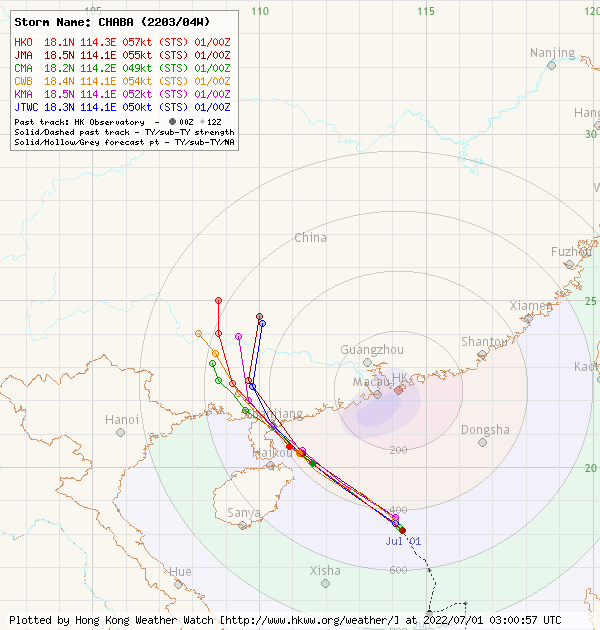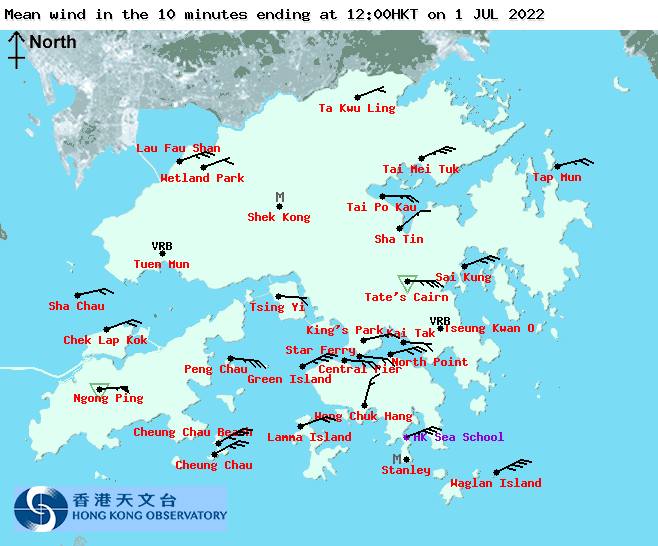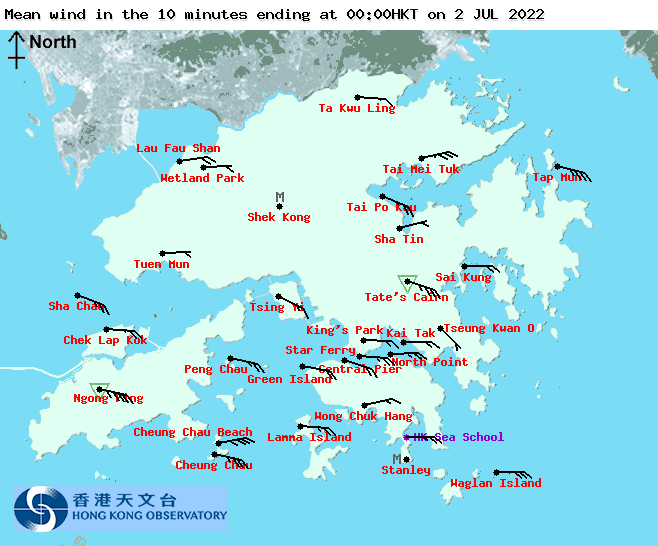TC Watch / 熱帶氣旋 > Selected TC Review / 重要熱帶氣旋回顧 > 202204W (CHABA 暹芭) [Refresh 更新]
 202204W (CHABA 暹芭) - Profile 檔案 202204W (CHABA 暹芭) - Profile 檔案 |
(First draft issued on July 10, 2022, final version issued on September 4, 2022)
(初稿於 2022 年 7 月 10 日發出,最後版本於 2022 年 9 月 4 日上載)
Brief profile of CHABA | 暹芭小檔案:
| JTWC number 聯合颱風警報中心 (JTWC) 號碼 | 04W |
| International number 國際編號 | 2203 |
| Period of existence 生存時期^ | 2022/06/29 11 HKT - 2022/07/03 17 HKT |
| Maximum 1-minute wind (JTWC) JTWC 一分鐘平均最高中心風速 | 75 knots 節 (Category 1 Typhoon 一級颱風) |
| Minimum pressure (JTWC) JTWC 最低氣壓 | 967 hPa 百帕 |
| Highest TC signal by HKO 香港天文台發出最高熱帶氣旋警告信號 |
8 (SE) (Gale or Storm Signal 烈風或暴風信號) |
| Closest point of approach by HKO 香港天文台所示之最接近距離 |
SW 310 km (real-time warning 實時報告) / WSW 310 km (TC report 熱帶氣旋報告) |
| Time of closest approach by HKO 香港天文台所示之最接近時間 |
2022/07/02 10 HKT (real-time warning and TC report 實時報告及熱帶氣旋報告) |
| Lowest pressure recorded at HKO 香港天文台錄得的最低氣壓 |
997.8 hPa 百帕 (2022/07/01 18:13 HKT) |
^Refers to the period between the HK Observatory's first and last bulletins for the tropical cyclone (with at least tropical depression intensity). For storms formed/dissipated/transformed into an extratropical cyclone outside the area bounded by 7-36°N and 100-140°E, information from the JTWC will be used instead.
^即香港天文台為該熱帶氣旋 (熱帶低氣壓級或更高) 作出發佈的時期。至於在北緯 7 至 36 度、東經 100 至 140 度外形成/消散/轉化為溫帶氣旋的風暴,本網將參考聯合颱風警報中心的資料。
TC signals in Hong Kong* 香港曾經生效的熱帶氣旋警告*:
| Signal 信號 |
Date and time 日期和時間 |
Distance from HK 與香港的距離 |
Predicted movement 預測移動趨勢 |
Max. 10-min winds 中心最高十分鐘平均風速 |
 |
2022/06/29 (WED) 21:10 HKT | SSE 740 km | NNW at 10 km/h | 45 km/h (25 knots, TD) |
 |
2022/06/30 (THU) 22:40 HKT | S 570 km | NNW at 18 km/h | 85 km/h (45 knots, TS) |
 |
2022/07/01 (FRI) 19:10 HKT | SSW 360 km | NW at 16 km/h | 110 km/h (60 knots, STS) |
 |
2022/07/02 (SAT) 16:20 HKT | WSW 330 km | NW at 16 km/h | 120 km/h (65 knots, T) |
 |
2022/07/03 (SUN) 14:10 HKT | WNW 430 km | N at 14 km/h | 75 km/h (40 knots, TS) |
 |
2022/07/03 (SUN) 19:40 HKT** | NW 480 km | NNE at 14 km/h | 45 km/h (25 knots, TD) |
*Based on the information from real-time tropical cyclone warning bulletins.
*根據實時熱帶氣旋警報資料。
**The Strong Monsoon Signal was issued 10 minutes after the cancellation of the #1 Standby Signal.
**天文台於一號戒備信號取消後 10 分鐘發出強烈季候風信號。
Percentile rank among storms with #8 Signal (at compilation of this review)*: *This measures the relative wind strength in Hong Kong caused by this storm compared with others that share the same signal. 指標顯示此風暴相對於其他發出同樣信號的風暴為香港帶來之風力強度 For more information, please refer to Wind Speed Data for TCs that Have Affected Hong Kong. 更多資訊載於 影響香港氣旋之風速數據 頁 |
Overall: 總計: |
|
Moderate 中等 |
|||
| Component Ranks 分部等級 | ||||||
| Reference stations: 參考站: |
|
Moderate 中等 |
||||
| Victoria Harbour: 維多利亞港: |
|
Moderate 中等 |
||||
| Urban: 市區: |
|
Moderate 中等 |
||||
| Offshore & high ground 離岸和高地: |
|
Moderate 中等 |
||||
Cyclones that attained similar rating (with signal #8): MERBOK (2017) 相近級別之熱帶氣旋 (八號信號):苗柏 (2017) |
||||||
IR imagery animation 紅外線雲圖動畫:
TC track from HKWW 本站的熱帶氣旋路徑圖:

TC track from HKO 天文台的熱帶氣旋路徑圖:


 Past HKWW Bulletins 本站發佈 Past HKWW Bulletins 本站發佈 |
Please click here for bulletins on this tropical cyclone. 請按這裡。
 Storm Development Overview 風暴發展概覽 Storm Development Overview 風暴發展概覽 |
Unless otherwise stated, all times below are in Hong Kong Standard Time (UTC+8)
除非特別註明,下文時間均為香港標準時間 (協調世界時加 8 小時)
About a week before CHABA's approach, global numerical forecast models had hinted at the formation of a tropical cyclone that would potentially enter the South China Sea and reach southern China.
A convective patch developed in the seas east of the Philippines on June 26, identified as tropical disturbance 97W. It moved westwards across Luzon and entered the South China Sea the next day. As the subtropical ridge north of the disturbance weakened, 97W stagnated in central South China Sea on June 28 as convections developed gradually. The JTWC issued a tropical cyclone formation alert in the morning of June 29, while a gale warning was issued by the JMA, and the NMC and HKO upgraded 97W into a tropical depression.
It was initially difficult to locate 97W's centre. As it continued to develop and wind field analysis charts became available, agencies made a westward relocation between the night of June 29 and the morning of June 30. The JTWC upgraded it into tropical depression 04W at 2 am June 30, while the JMA upgraded it into tropical storm CHABA at 8 am. Influenced by a weak ridge in northeastern South China Sea, CHABA was projected to move north to north-northwest initially. That ridge was predicted to strengthen slightly, allowing CHABA to turn northwest in the northern South China Sea and move towards western Guangdong.
CHABA appeared asymmetric and most of its deep convections were concentrated in the southern side. The storm's structure tightened over June 30 and convections were seen to develop over its northern semicircle in the latter part of that day. The JMA upgraded CHABA into a severe tropical storm at 2 am July 1.
In the morning of July 1, CHABA started to take on a northwesterly track. It continued to intensify in very warm seas with good divergence aloft. While the storm generally moved northwest on most of July 1, it decelerated somewhat in the afternoon, with some irregular jogs. This allowed further time for CHABA to intensify; the JTWC upgraded it into a typhoon at 2 am July 2. The JMA, NMC and HKO all made the upgrade at 8 am. CHABA was developing a banding eye as it approached southern China.
CHABA turned north-northwest in the morning of July 2. According to the NMC, CHABA made landfall near Dianbai, Maoming in western Guangdong at around 3 pm. The storm's convections started to thin as it moved inland. As the weak ridge in southeastern China weakened, CHABA turned north into eastern Guangxi early on July 3 as a severe tropical storm. It weakened gradually into an area of low pressure that night in northern Guangxi near Guilin.
暹芭來襲前約一星期,全球數值預測模式已預計將有熱帶氣旋生成,有機會進入南海及靠近華南。
6 月 26 日,一團對流雲帶於菲律賓以東的海域發展,被編號為熱帶擾動 97W。它於翌日西移並橫過呂宋,進入南海。隨著 97W 以北的副熱帶高壓脊減弱,97W 於 28 日在南海中部徘徊,對流逐漸發展。29 日早上,聯合颱風警報中心對其發出熱帶氣旋形成警報,日本氣象廳發出烈風警告,而中國中央氣象台及香港天文台則將其升格為熱帶低氣壓。
初時 97W 的中心位置較難辨認。隨著風暴繼續發展及根據當時的風場掃描,各氣象機構於 6 月 29 日晚至 30 日早上將 97W 向西方重新定位。聯合颱風警報中心於 30 日上午 2 時將其升格為熱帶低氣壓 04W,而日本氣象廳則於上午 8 時將其升格為熱帶風暴暹芭。受南海東北部的一道弱高壓脊影響,當時預料暹芭初期將向北至西北偏北移動;該脊稍後將略為增強,令暹芭於南海北部轉向西北,趨向廣東西部。
暹芭的環流並不對稱,其深層對流集中於南方。風暴結構於 6 月 30 日變得緊密,當天稍後對流於其北半圓發展。日本氣象廳於 7 月 1 日上午 2 時將暹芭升格為強烈熱帶風暴。
7 月 1 日早上,暹芭開始向西北移動,並繼續於非常溫暖的海域及高空輻散良好的環境中增強。雖然風暴於 1 日大致向西北移動,但它於下午有所減速,移動略顯不規則;這給予暹芭時間進一步增強。聯合颱風警報中心於 2 日上午 2 時將暹芭升格為颱風,而日本氣象廳、中國中央氣象台及香港天文台均於上午 8 時升格。暹芭靠近華南時正建立雲捲風眼。
暹芭於 7 月 2 日早上轉向西北偏北移動。中國中央氣象台表示暹芭於下午 3 時左右登陸廣東西部的茂名市電白區一帶。隨著暹芭進入內陸,其對流開始轉薄。位於中國東南部的弱高壓脊有所減弱,暹芭於 7 月 3 日早段轉向偏北移動,以強烈熱帶風暴強度進入廣西東部。風暴逐漸減弱,於 3 日晚在桂林一帶的廣西北部減弱為低壓區。
 Weather in Hong Kong During Approach 風暴影響時香港天氣狀況 Weather in Hong Kong During Approach 風暴影響時香港天氣狀況 |
Link to relevant HKO weather report bulletins:
29/6 ●
30/6 ●
1/7 ●
2/7 ●
3/7
香港天文台相關天氣報告連結:29/6 ●
30/6 ●
1/7 ●
2/7 ●
3/7
The weather was generally fine in Hong Kong on June 29, with localized scattered showers. As CHABA was upgraded into a tropical depression, the HKO indicated that the #1 Signal would be considered that night, and that winds and showers would intensify the next day.
The #1 Standby Signal was issued at 9:10 pm June 29, when CHABA was about 740 km south-southeast of Hong Kong. In the morning of June 30, the HKO announced that the #1 Signal would remain in force before 6 pm the same day, and that it would consider issuing the #3 Signal that night. The time of signal change was narrowed down to between 10 pm and midnight afterwards. Locally, the weather turned unstable on June 30 with occasional squally showers. In offshore waters and on high ground, easterly winds picked up after sunset. The HKO issued the #3 Strong Wind Signal at 10:40 pm as local winds were forecast to strengthen further. CHABA had intensified into a tropical storm and was around 570 km south of Hong Kong at that time.
One of CHABA's outer rainbands reached Hong Kong from the east near midnight July 1. The HKO issued the Amber Rainstorm Warning at 12:50 am, which lasted less than 1.5 hours. Most locations in Hong Kong experienced a gradual increase in wind speeds in the morning. By the late morning, sustained storm force winds were registered at Ngong Ping, an elevated station. Winds at Waglan Island reached gale force, while strong force winds were observed more widely, including stations within the Victoria Harbour such as Central Pier and North Point. The official activities of the 25th Hong Kong's handover anniversary and the inaugural ceremony for the new government proceeded as normal in the morning in spite of the rather windy and unstable weather.
At around 10 am July 1, the HKO indicated that the #3 Signal would remain in force before 5 pm, while leaving room for a potential upgrade in the signal citing that such possibility depended on CHABA's development and the change in local winds. As a major rainband arrived shortly after noon, the weather deteriorated further. Gale force winds began to be observed at Cheung Chau, Green Island, Peng Chau, Tap Mun and Tate's Cairn in the early afternoon. Seeing the increase in wind speeds and expecting the trend to continue that night, the HKO announced that the #8 Signal would be considered between 6 pm and 9 pm in its tropical cyclone bulletin issued for 3 pm. The Amber Rainstorm Warning was issued again at 3:15 pm when a wider rainband approached the territory. This time, the Warning lasted 2 hours until 5:15 pm.
Shortly after its projected time frame for the #3 Signal to remain in force had expired, the HKO issued the Pre-No. 8 Special Announcement at 5:10 pm to give the public a 2-hour warning prior to the signal upgrade. Due to July 1 being a holiday and the advance warning that CHABA would come closer to the territory, the scene of commuters rushing back home in the evening rush hour did not take place this time. Cargo handling at the various terminals were suspended at 5 pm, and ferry services were gradually suspended in the next few hours. The #8 Southeast Gale or Storm Signal was issued at 7:10 pm when CHABA was around 360 km south-southwest of Hong Kong. Winds were still coming in from the east, but were expected to veer to the southeast the next day.
Several rainbands affected Hong Kong during the night. In spite of this, local winds remained relatively stable, with a few exceptions such as Cheung Chau and Kowloon Star Ferry Pier where there was a slight increase in wind speeds later that night. The HKO initially suggested that the #8 Signal would not be cancelled before 5 am July 2, but this was extended to noon before dawn, and further to 4 pm in its tropical cyclone bulletin for 9 am July 2. The combination of a decrease in CHABA's forward speed and its more northerly direction meant that CHABA's closest point of approach to Hong Kong was delayed to the morning of July 2, when it passed at a distance of around 310 km to the west-southwest. A number of stations registered the strongest winds during CHABA's approach at this point. The sustained wind speed at Chek Lap Kok, one of the eight reference stations, reached 60 km/h; it was 3 km/h below the gale force threshold.
Winds turned southeast gradually in the late morning of July 2. At 2 pm, the HKO announced that CHABA was about to make landfall near Zhanjiang, and that it would consider lowering the signal to #3 between 4 pm and 8 pm. The signal change was eventually made at 4:20 pm, more than 1 hour after CHABA had made landfall in western Guangdong. As the #8 Signal was in force for most of the daytime, the grand opening of the Hong Kong Palace Museum was postponed to the day after.
Local winds did not weaken significantly after the signal was lowered to #3, and actually strengthened in certain places later that night. Green Island, an elevated station near the western boundary of the Victoria Harbour, recorded a wind speed of 70 km/h just before 10 pm July 2 as southerly winds set in. Winds there hovered near the boundary between strong force and gale force in the next 12 hours or so.
CHABA's influence on Hong Kong started to diminish on July 3, and winds began to moderate in the early afternoon. The #3 Strong Wind Signal was replaced by the #1 Standby Signal at 2:10 pm as CHABA moved to around 430 km west-northwest of Hong Kong. The #1 Signal was cancelled at 7:40 pm the same day. By the time of the signal cancellation, strong south to southwesterly winds were still occasionally observed in offshore waters and on high ground. The HKO thus issued the Strong Monsoon Signal at 7:50 pm, which remained in force for almost 36 hours.
Due to an active southwesterly airstream, the weather in Hong Kong remained unstable in the several days following CHABA's departure. During CHABA's approach, the government received 45 reports of fallen trees and one flooding report. Three people were injured and sought medical assistance at the Accident and Emergency Department of public hospitals. In the morning of July 2, the Government Flying Service received an emergency rescue request from Fujing 001, a mainland engineering vessel that broke into two in the vicinity of CHABA. Only 3 out of the 30 crew members were rescued, while another one was later rescued by mainland authorities. It was reported that the vessel went drifting in the seas due to a broken anchor chain.
The HKO published several blog posts (in Chinese) during and after CHABA's approach, explaining their rationale behind the timing of the signal changes. The HKO expressed that CHABA intensified at a rate quicker than predicted by numerical models, and moved along a more easterly track. These factors prolonged the period during which gales and squally showers affected the territory. The blog post published on July 4 explained that the "U.S. model", believed to be GFS, had a forecast track that differed significantly from the other models and a more volatile intensity estimation, and was thus not as reliable and may be excluded in formulating the official forecast.
香港 6 月 29 日的天氣大致良好,但局部地區有零散驟雨。隨著暹芭被升格為熱帶低氣壓,天文台表示將於當晚考慮發出一號戒備信號,風勢及驟雨將於翌日增強。
一號戒備信號於 6 月 29 日下午 9 時 10 分發出,當時暹芭位於香港東南偏南約 740 公里。30 日早上,天文台表示一號信號將於當日下午 6 時前維持,並會於當晚考慮改發三號信號。其後,天文台收窄改發三號信號的時間帶至晚上 10 時至午夜。本港天氣於 30 日轉趨不穩定,間中有狂風驟雨,離岸及高地日落後東風增強。由於預料本地風力將進一步上升,天文台於下午 10 時 40 分改發三號強風信號。暹芭已增強為熱帶風暴,當時位於香港以南約 570 公里。
7 月 1 日午夜時份,暹芭一道外圍雨帶從東面到達本港。天文台於上午 12 時 50 分發出黃色暴雨警告,生效少於 1.5 小時後取消。香港大部分地區當天上午風勢逐漸增強;至上午末段,位處高地的昂坪持續風速達暴風強度,橫瀾島吹烈風,而強風影響的地區較為廣泛,包括中環碼頭及北角等維港內的地點。雖然風勢頗大且天氣不穩定,1 日上午的香港回歸 25 周年官方活動及新一屆政府就職典禮得以如期舉行。
至 7 月 1 日上午約 10 時,天文台表示三號信號將於下午 5 時前維持,亦留下改發更高信號的空間,指出改發與否取決於暹芭的發展及本港風力變化。隨著一道較廣闊的雨帶於中午後不久到達,本港天氣進一步轉差,下午初段長洲、青洲、坪洲、塔門及大老山等吹烈風。由於風勢增強且預料趨勢會於晚間持續,天文台於下午 3 時的熱帶氣旋警報中宣布會考慮於下午 6 至 9 時改發八號信號。下午另一道廣闊雨帶到達,黃色暴雨警告於 3 時 15 分再度發出,持續兩小時至 5 時 15 分取消。
天文台預計三號信號維持時段結束後不久,預警八號熱帶氣旋警告信號之特別報告於下午 5 時 10 分發出,表示將於兩小時內改發八號信號。適逢公眾假期,加上已提早警示市民暹芭將會進一步靠近,因此市民於下午繁忙時間及信號轉變前趕回家的景象未有出現。貨櫃碼頭交收服務於下午 5 時停止,而渡輪服務亦於其後數小時陸續暫停。八號東南烈風或暴風信號於下午 7 時 10 分發出,當時暹芭位於香港西南偏南約 360 公里。雖然香港仍然吹東風,但預料會於翌日轉吹東南風。
晚間數條雨帶掠過香港,但除部分地區如長洲及九龍天星碼頭風速稍為上升外,本地風勢相對穩定。天文台原先表示八號信號將於 7 月 2 日上午 5 時前維持,其後於破曉前延長至正午前維持,繼而於上午 9 時的熱帶氣旋警報中再度延長至下午 4 時前維持。由於暹芭曾減速,而且其路徑較為偏北,風暴最接近香港的時間延後至 2 日上午,於西南偏西方約 310 公里掠過,部分地區此時錄得風暴襲港時最強風力。八個參考站之一的赤鱲角持續風速達每小時 60 公里,較烈風下限低 3 公里。
7 月 2 日上午後段本港漸轉吹東南風。下午 2 時,天文台表示暹芭即將於湛江一帶登陸,將考慮於下午 4 至 8 時改發三號強風信號。該信號最終於下午 4 時 20 分,即暹芭登陸廣東西部一個多小時後發出。由於八號信號日間大部分時間生效,原訂於當日開幕的香港故宮文化博物館需押後一天開放。
三號信號發出後,本地風勢並沒有明顯減弱,部分地區更有所增強。位於維港西部邊緣的高地站青洲,7 月 2 日晚轉吹南風後於下午 10 時前錄得風速每小時 70 公里,其後半天風力維持強風上限至烈風下限。
暹芭對香港的影響於 7 月 3 日開始減少,風勢於下午初段轉趨緩和。三號強風信號於下午 2 時 10 分被一號戒備信號取代,暹芭當時已移至香港西北偏西約 430 公里,而一號信號亦於下午 7 時 40 分取消。信號取消時本港離岸及高地仍間中吹達強風程度的南至西南風,因此天文台於下午 7 時 50 分發出強烈季候風信號,接近 36 小時後才取消。
受活躍西南氣流影響,暹芭遠離後數天香港天氣仍然不穩定。暹芭襲港時政府共接獲 45 宗塌樹及 1 宗水浸報告;3 人在風暴中受傷並於公立醫院急症室接受治療。7 月 2 日早上,政府飛行服務隊接獲內地工程船「福景 001」的救援請求,當時該船於暹芭中心附近,船身斷成兩截。船上 30 名船員只有 3 人獲救,另外一人其後由內地方面救起。根據報導,該艘工程船因錨鏈斷裂而於海上飄浮。
天文台於暹芭來襲時及其後在「天氣隨筆」網誌中解釋其信號轉變的時機,表示暹芭增強速度較數值模式預測快,路徑亦較為偏東,這些因素加長了烈風及狂風驟雨影響香港的時間。在 7 月 4 日的發文中,天文台解釋「美國模式」(相信是 GFS 模式) 與其他模式的預測路徑出現明顯差別,強度預測亦較飄忽,因此參考價值相對較低,在制定官方預測時可能會被剔除。
 Image Gallery 圖片庫 Image Gallery 圖片庫 |
Figure 1 - GFS ensemble forecast track and intensity at 8 am June 26 (left) and June 28 (right) (source: Tropical Tidbits)
圖 1 - 6 月 26 日 (左) 及 28 日 (右) 上午 8 時之 GFS 集成預報路徑及強度 (來源:Tropical Tidbits)
Figure 2 - Forecast tracks from various numerical models on June 28 (source: Typhoon2000.com)
圖 2 - 6 月 28 日各數值模式之預測路徑 (來源:Typhoon2000.com)
Figure 3 - Satellite image of CHABA at its initial stage of formation in the South China Sea
圖 3 - 暹芭於南海形成初期之衛星雲圖
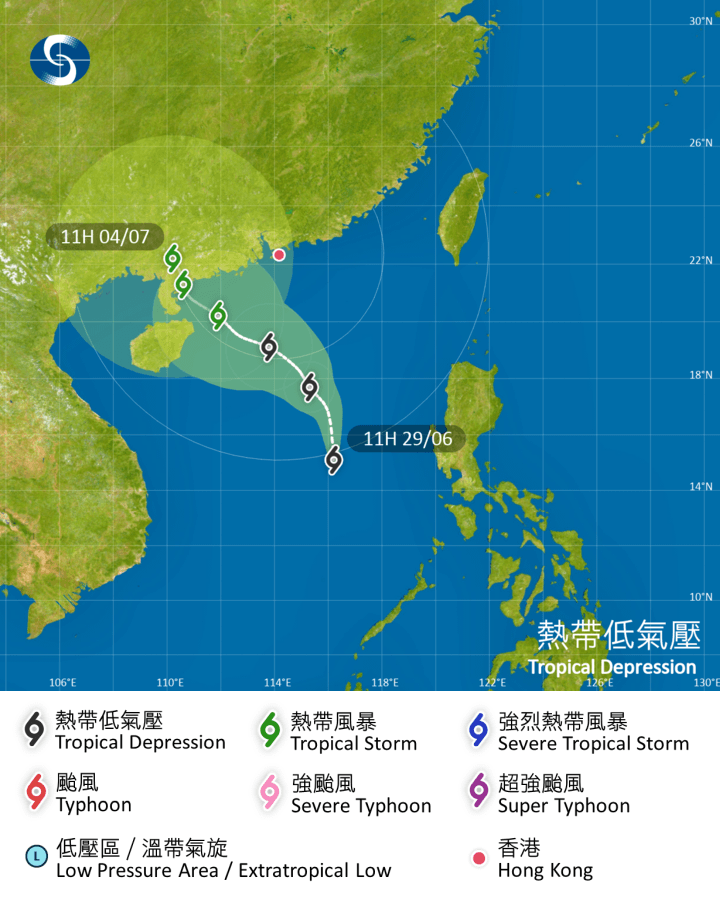
Figure 4 - HKO's initial forecast track
圖 4 - 香港天文台之初始預測路徑圖
Figure 5 - Forecast tracks from various official agencies on June 30 (left) and July 1 (right)
圖 5 - 6 月 30 日 (左) 及 7 月 1 日 (右) 各官方氣象台之預測路徑
Figure 6 - Wind field analysis at 10 pm June 29 (left) and 10:12 pm July 1 (right)
圖 6 - 6 月 29 日下午 10 時 (左) 及 7 月 1 日下午 10 時 12 分 (右) 之風場掃描
Figure 7 - Steering flow chart at 8 am July 1
圖 7 - 7 月 1 日上午 8 時之駛流場分佈圖
Figure 8 - Radar images at 12:24 pm July 1 (left) and 6 am July 2 (right)
圖 8 - 7 月 1 日下午 12 時 24 分 (左) 及 2 日上午 6 時之雷達圖
Figure 9 - Satellite image of CHABA near its peak intensity
圖 9 - 暹芭接近巔峰強度時之衛星雲圖

Figure 10 - Wind, temperature and humidity distribution map at 9:40 am July 2 showing the prevalence of strong force winds (or above; red barbs) in Hong Kong
圖 10 - 7 月 2 日上午 9 時 40 分之風、溫度及濕度分佈圖顯示本港廣泛地區吹強風 (或更高;以紅色風矢標示)
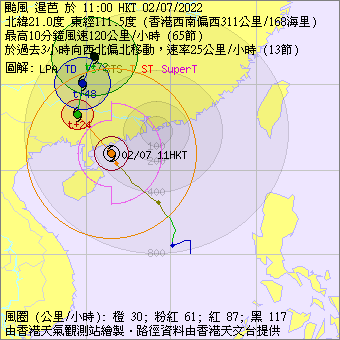
Figure 11 - HKO's forecast track and estimated wind radii at 11 am July 2. Hong Kong was at the boundary of the estimated gale force wind area.
圖 11 - 7 月 2 日上午 11 時香港天文台之預測路徑及估算風圈圖,香港當時正處於估計烈風範圍的邊緣
Figure 12 - Local wind distribution maps at 6-hour intervals from noon July 1 to 6 pm July 2
圖 12 - 7 月 1 日正午至 2 日下午 6 時每 6 小時之本港風勢分布圖
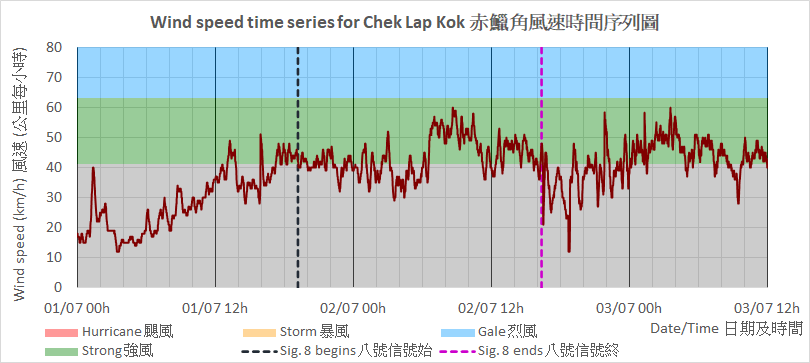
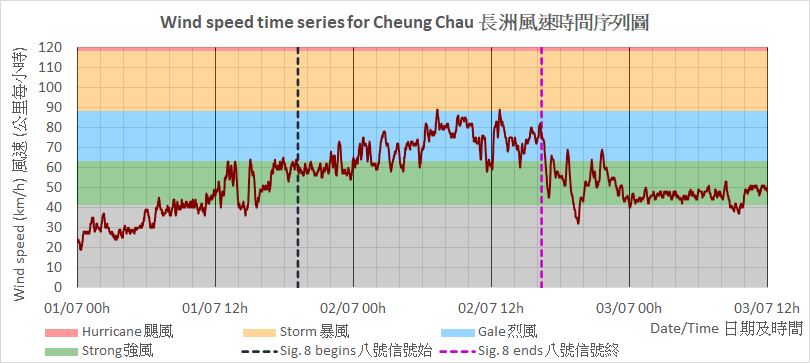


Figure 13 - Wind speed time series at Chek Lap Kok, Cheung Chau, Green Island and Kowloon Star Ferry Pier (top to bottom) for July 1 to 3
圖 13 - 赤鱲角、長洲、青洲及九龍天星碼頭 (上至下) 於 7 月 1 至 3 日之風速時間序列圖

Figure 14 - Rainfall distribution map for July 2
圖 14 - 7 月 2 日之雨量分佈圖
 Winds Recorded at Reference Stations 參考站所錄得的風速 Winds Recorded at Reference Stations 參考站所錄得的風速 |
The following table lists the maximum 10-minute average (sustained) wind speed recorded while tropical cyclone signals were in force. In some occasions, it is possible that the strongest winds were not recorded when the highest signal was in force.
下表列出各站於熱帶氣旋警告信號生效時所錄得的最高 10 分鐘平均 (持續) 風速,留意此風速不一定於最高信號生效期間錄得。
| Station 風速站 |
Max. 10-min avg. wind speed 最高十分鐘平均風速 |
Beaufort classification 蒲福氏風級分類 |
| Chek Lap Kok 赤鱲角 | 60 km/h | STRONG 強風 |
| Cheung Chau 長洲 | 89 km/h | STORM 暴風 |
| Kai Tak 啟德 | 42 km/h | STRONG 強風 |
| Lau Fau Shan 流浮山 | 51 km/h | STRONG 強風 |
| Sai Kung 西貢 | 57 km/h | STRONG 強風 |
| Sha Tin 沙田 | 33 km/h | Fresh 清勁 |
| Ta Kwu Ling 打鼓嶺 | 35 km/h | Fresh 清勁 |
| Tsing Yi (SHL) 青衣蜆殼油庫 | 48 km/h | STRONG 強風 |
| Number of stations recording at least STRONG force (force 6 - 7) winds: | 6 |
| Number of stations recording at least GALE force (force 8 - 9) winds: | 1 |
| Number of stations recording at least STORM force (force 10 - 11) winds: | 1 |
| Number of stations recording HURRICANE force (force 12) winds: | 0 |
| 錄得 強風 (6 - 7 級) 或更高風速的站數: | 6 |
| 錄得 烈風 (8 - 9 級) 或更高風速的站數: | 1 |
| 錄得 暴風 (10 - 11 級) 或更高風速的站數: | 1 |
| 錄得 颶風 (12 級) 風速的站數: | 0 |
 Charts and Figures 各項數據 Charts and Figures 各項數據 |
Table 1: Track data from HKWW:
表一 : 香港天氣觀測站之路徑資料
YYMMDDZZ Lat Long Wind |
Table 2: Maximum gust and hourly average wind speed recorded in Hong Kong from HKO:
表二 : 香港天文台公佈的各站最高每小時平均風力和陣風數據 (英文)
Maximum Gust |
Maximum Hourly Mean Wind |
|||||||
|---|---|---|---|---|---|---|---|---|
| Direction |
Speed (km/h) |
Date/Month |
Time |
Direction |
Speed (km/h) |
Date/Month |
Time |
|
| Central Pier | E | 81 | 1/7 | 12:57 | E | 46 | 1/7 | 13:00 |
| Cheung Chau | ESE | 107 | 2/7 | 07:08 | ESE | 83 | 2/7 | 10:00 |
| Cheung Chau Beach | E | 101 | 2/7 | 06:14 | E | 77 | 2/7 | 10:00 |
| Green Island | E | 106 | 2/7 | 07:13 | S | 64 | 2/7 | 23:00 |
| Hong Kong International Airport | SSW | 93 | 2/7 | 21:47 | ESE | 54 | 2/7 | 09:00 |
| S | 93 | 2/7 | 21:48 | |||||
| Kai Tak | E | 80 | 2/7 | 12:08 | E | 37 | 2/7 | 09:00 |
| King's Park | E | 75 | 2/7 | 06:52 | E | 35 | 1/7 | 23:00 |
| Lamma Island | E | 90 | 1/7 | 13:00 | ESE | 48 | 2/7 | 10:00 |
| Lau Fau Shan | E | 79 | 2/7 | 09:39 | SSE | 46 | 3/7 | 02:00 |
| SE | 79 | 2/7 | 15:30 | |||||
| Ngong Ping | E | 149 | 2/7 | 12:21 | E | 102 | 2/7 | 07:00 |
| North Point | E | 83 | 1/7 | 21:45 | ENE | 48 | 1/7 | 12:00 |
| Peng Chau | ESE | 89 | 2/7 | 06:29 | E | 58 | 1/7 | 13:00 |
| Ping Chau | ENE | 49 | 1/7 | 16:01 | E | 15 | 1/7 | 16:00 |
| Sai Kung | ENE | 81 | 1/7 | 12:57 | SSE | 54 | 2/7 | 22:00 |
| Sha Chau | S | 96 | 2/7 | 21:48 | S | 63 | 3/7 | 00:00 |
| Sha Lo Wan | E | 104 | 2/7 | 09:44 | E | 40 | 2/7 | 09:00 |
| Sha Tin | NE | 64 | 1/7 | 13:43 | SSE | 25 | 2/7 | 18:00 |
| Star Ferry (Kowloon) | ESE | 82 | 2/7 | 12:07 | E | 46 | 2/7 | 13:00 |
| Ta Kwu Ling | E | 68 | 2/7 | 08:21 | E | 28 | 2/7 | 09:00 |
| Tai Mei Tuk | ENE | 93 | 1/7 | 16:11 | E | 60 | 1/7 | 17:00 |
| Tai Mo Shan | SE | 138 | 2/7 | 09:49 | ESE | 91 | 2/7 | 13:00 |
| SE | 138 | 2/7 | 09:53 | |||||
| Tai Po Kau | E | 92 | 1/7 | 13:10 | ESE | 48 | 2/7 | 07:00 |
| ESE | 48 | 2/7 | 08:00 | |||||
| Tap Mun East | E | 94 | 1/7 | 14:40 | ESE | 68 | 2/7 | 07:00 |
| SE | 94 | 2/7 | 21:07 | |||||
| Tate's Cairn | E | 109 | 1/7 | 14:39 | ESE | 75 | 1/7 | 18:00 |
| Tseung Kwan O | SE | 60 | 2/7 | 10:19 | SE | 22 | 2/7 | 16:00 |
| Tsing Yi Shell Oil Depot | E | 83 | 2/7 | 08:58 | SE | 43 | 2/7 | 23:00 |
| Tuen Mun Government Offices | SSE | 83 | 2/7 | 22:08 | SSE | 36 | 2/7 | 23:00 |
| SSE | 36 | 3/7 | 00:00 | |||||
| Waglan Island | E | 95 | 1/7 | 12:40 | ENE | 70 | 1/7 | 12:00 |
| Wetland Park | SE | 65 | 2/7 | 16:14 | ESE | 24 | 2/7 | 16:00 |
| SSE | 24 | 3/7 | 02:00 | |||||
| Wong Chuk Hang | ENE | 84 | 1/7 | 23:58 | ENE | 32 | 2/7 | 09:00 |
Table 3: Rainfall (in millimetres) contributed by CHABA from HKO (figures in brackets are based on incomplete hourly data):
表三 : 香港天文台公佈的各站雨量資料 (英文) (方括號內之數據由不完整之每小時資料擷取)
| 29-Jun |
30-Jun |
01-Jul |
02-Jul |
03-Jul |
Total Rainfall (mm) |
||
|---|---|---|---|---|---|---|---|
| Hong Kong Observatory (HKO) | 0.7 |
64.9 |
63.0 |
72.4 |
0.0 |
201.0 |
|
| Hong Kong International Airport (HKA) | 0.1 |
33.0 |
45.1 |
108.6 |
0.1 |
186.9 |
|
| Cheung Chau (CCH) | 0.0 |
15.5 |
35.0 |
34.5 |
0.0 |
85.0 |
|
| H23 | Aberdeen | 0.0 |
49.5 |
44.0 |
47.5 |
0.0 |
141.0 |
| N05 | Fanling | 0.0 |
26.5 |
21.0 |
68.5 |
2.0 |
118.0 |
| N13 | High Island | 7.5 |
55.5 |
35.0 |
27.0 |
1.0 |
126.0 |
| K04 | Jordan Valley | 1.0 |
69.0 |
63.5 |
94.5 |
5.0 |
233.0 |
| N06 | Kwai Chung | 0.5 |
55.0 |
57.5 |
96.0 |
0.0 |
209.0 |
| H12 | Mid Levels | 0.0 |
79.0 |
63.0 |
60.5 |
0.0 |
202.5 |
| N09 | Sha Tin | 3.0 |
35.5 |
53.0 |
107.0 |
4.0 |
202.5 |
| H19 | Shau Kei Wan | 0.0 |
77.0 |
62.0 |
47.0 |
2.0 |
188.0 |
| SEK | Shek Kong | 1.5 |
18.0 |
42.0 |
90.5 |
0.0 |
152.0 |
| K06 | So Uk Estate | 1.5 |
65.0 |
58.0 |
95.5 |
0.0 |
220.0 |
| R31 | Tai Mei Tuk | 2.5 |
27.0 |
21.5 |
69.0 |
11.5 |
131.5 |
| R21 | Tap Shek Kok | 1.5 |
24.0 |
31.0 |
90.5 |
0.0 |
147.0 |
| N17 | Tung Chung | 0.0 |
33.0 |
54.5 |
119.5 |
0.0 |
207.0 |
| TMR | Tuen Mun Reservoir | 11.9 |
23.4 |
35.4 |
121.8 |
2.1 |
194.6 |
Last Accessed 最近訪問日期: Sun Sep 08 2024 12:47:11 HKT
Last Modified 最近修訂日期: Mon Jul 24 2023






